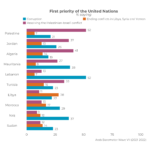“Over eighteen days in January 2011, Tahrir Square in Cairo was featured in broadcasts around the world as the epicenter of Egypt’s thawra, or revolution. Festooned with flags and signs and posters, pulsing with the beat of music and speakers and protest chants from loudspeakers and stages, and filled with the sense of changing history, the square was temporarily transformed by thousands of protesters from a large traffic circle into an iconic protest forum. 1 The Tahrir protests inspired the takeover and makeover of other squares in Arab capitals, including the Pearl roundabout in Manama, Bahrain, and the “change square” in Sana’a, Yemen. In only eighteen days, the scale and intensity of the protests across Egyptian cities induced Egypt’s army high command to announce that Husni Mubarak, a former air force commander who had been in power since 1981, would step down. In his place, the army would rule temporarily until a new president and parliament were elected…”
Visit External SiteTopics
- Charity2
- Corruption113
- COVID-1969
- Democracy35
- Discrimination13
- Economy226
- Education51
- Environment36
- Extremism19
- Freedoms50
- Gender Issues159
- Governance253
- Health44
- International Relations193
- Labor Market35
- Media31
- Migration63
- Political Institutions213
- Political Participation33
- Political Systems60
- Refugees6
- Religion118
- Security31
- Social Justice44
- Wellbeing2
- Youth75


